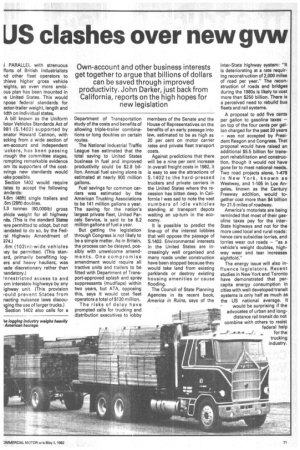US clashes over new gvw
Page 67

If you've noticed an error in this article please click here to report it so we can fix it.
J PARALLEL with strenuous forts of British industrialists Id other fleet operators to .3hieve higher gross vehicle 'eights, an even more ambiDUS plan has been mounted in ie United States. This would noose federal standards for actor-trailer weight, length and Idth on individual states.
A bill known as the Uniform lotor Vehicles Standards Act of 981 (S.1402) supported by enator Howard Cannon, with acking from a wide section of ovn-account and independent .uckers, has been passing 'rough the committee stages, rompting remarkable evidence om its supporters of the costwings new standards would lake possible.
Section 1402 would require tates to accept the following :andards: 4,.6m (48ft) single trailers and .5m (28ft) doubles.
3.3 tonnes (80,0001b) gross ahicle weight for all highway nits. (This is the standard States rare permitted to adopt, but not landated to do so, by the Fedral Highway Amendment of 974.) .fim (102in)-wide vehicles lay be permitted. (This stenard, primarily benefiting logers and heavy hauliers, was lade discretionary rather than mndatory.) lnrestricted access to and urn interstate highways by any ighway unit. (This provision ou Id prevent States from nacting nuisance laws discou3ging the use of larger trucks.) Section 1402 also calls for a Department of Transportation study of the costs and benefits of allowing triple-trailer combinations or long doubles on certain routes.
The National Industrial Traffic League has estimated that the total saving to United States business in fuel and improved productivity could be $2.8 billion. Annual fuel saving alone is estimated at nearly 900 million gallons.
Fuel savings for common carriers was estimated by the American Trucking Associations to be 141 million gallons a year. The saving for the nation's largest private fleet, United Parcels Service, is said to be 6.2 million gallons of fuel a year.
But getting the legislation through Congress is not likely to be a simple matter. As in Britain, the process can be delayed, possibly with unwelcome amendments. One compromise amendment would require all tractive units and trailers to be fitted with Department of Transport-approved splash and spray suppressants (mudflaps) within two years, but ATA, opposing this, says it would cost fleet operators a total of $120 million.
The risks of delay have prompted calls for trucking and distribution executives to lobby members of the Senate and the House of Representatives on the benefits of an early passage into law, estimated to be as high as 20 per cent on motor carrier rates and private fleet transport costs.
Against predictions that there will be a nine per cent increase in overall freight costs in 1982, it is easy to see the attractions of S.1402 to the hard-pressed truckers and private carriers in the United States where the recession has bitten deep. In California I was sad to note the vast numbers of idle vehicles standing at transport depots waiting an up-turn in the economy.
It is possible to predict the line-up of the interest lobbies that will oppose the passage of 5.1402. Environmental interests in the United States are increasingly well organised and many roads under construction have been stopped because they would take land from existing parklands or destroy existing housing amenities or cause flooding.
The Council of State Planning Agencies in its recent book, America in Ruins, says of the
inter-State highway system: It is deteriorating at a rate requiring reconstruction of 2,000 miles of road per year." The reconstruction of roads and bridges during the 1980s is likely to cost more than $250 billion. There is a perceived need to rebuild bus fleets and rail systems.
A proposal to add five cents per gallon to gasoline taxes — on top of the four cents per gallon charged for the past 20 years — was not accepted by President Reagon and Congress. That proposal would have raised an additional $5.5 billion for transport rehabilitation and construction, though it would not have gone far to meet national needs. Two road projects alone, 1-478 in New York, known as Westway, and 1-105 in Los Angeles, known as the Century Freeway addition, would together cost more than $4 billion for 21.5 miles of roadway.
America's motorists are being reminded that most of their gasoline taxes pay for the interState highways and not for the more used local and rural roads: hence cars subsidise lorries, and lorries wear out roads — "as a vehicle's weight doubles, highway wear and tear increases eightfold."
The energy issue will also influence legislators. Recent studies in New York and Toronto have demonstrated that percapita energy consumption in cities with well developed transit systems is only half as much as the US national average. It would be surprising if the advocates of urban and longdistance rail transit do not combine with others to resist federal help forthe trucking industry.




































































